Autumn has started with temperatures of 27 degrees centigrade and sunshine. We have had one heavy rainfall and I am pleased to see that most of the trees look like they have come through the dry summer. I think the two consecutive wet winters and spring had filled up the ground water as I did not (could not) water the trees but only the vegetable garden and some of the young plants.
This is our Belle de Boskoop. I like the large, crunchy apples of the Belle de Boskoop but even counting on our other three apple trees, we are going to have no storage problems for the apple harvest – there is just enough to keep us going for eating and a bit more for compote to freeze.
The pear harvest is also meagre but I am not complaining as I am only too happy that they have survived.
What did surprise me was that some cyclamen shot through the soil a few days after the rain. The corms had lain in the baking soil until the rain and the season stimulated the flower production. The leaves are appearing slowly like an afterthought.
Not all plants have such a good synchronisation with the seasons and this poppy that has self seeded from the spring ones has skipped a few months.
I thought this Swallowtail (Papilio machaon) caterpillar on my fennel stalks had missed the boat for this year but checking in Wiki I found out that the later broods can overwinter as pupae which is what I presume will happen to this one.
One of my great disappointments in the garden is the Heptacodium micanoides that I planted to replace the shrub I bought (and lost ) as Heptacodium jasminoides. I raved about this shrub Heptacodium jasminoides, the bumble bee tree in 2012 and again The last days of September in 2013. I have two healthy H. micanoides now but neither of them are perfumed. Not surprising, you say, as they are different species but as far as I can understand the difference is only a name change, as there is only the one representative of the genus. The second difference is that although the bumble bees are attracted to the shrub it is not pulling in the bees like my first Heptacodium. Any ideas?
Last year I had a beautiful patch of Hibiscus trionum, or Flower of an hour. I had hopes that here they might be perennial, or at least self-seed, but despite the mild winter I have found only one flower. Never mind, I kept the seeds from last year so they can be sown again in the spring in the ground or in pots.
On the topic of puzzles – what is this honey bee doing? I had cut the basil I grow in a pot on the patio about a week ago to dry the leaves but I left the stalks as they are quite happy to push out some more leaves. While having our lunch we noticed bees around the pot and one bee in particular seemed to be treating a damaged leaf like an ice lolly.
The long tongue was slid over the back and then the front of the leaf. It was just after midday and their was no obvious moisture on the leaf and I wonder if they can extract oils from the leaves? No wonder their honey tastes so good!
The bees are also through the Cosmos sulphureus. They must keep their options open as when we go walking we are greeted first by the smell of the ivy flowers and then the noise of the bees overhead. The ivy is just opening here and the flowers that receive more sun, such as the ones on the tops of the trees, open first. It is the last great feast for all the pollinators.
The male ivy bees (Colletes hedera) which nest in a dry path not far from the house are searching hopefully for females that are just starting to appear.
Back to the garden and another puzzle. This is called “Linda’s pretty pink flower”. We saw it in a friend’s garden and we were delighted to be given one for our own garden. Linda had momentarily forgotten the name and I forget to ask her whenever I see her! Can anyone help out here?
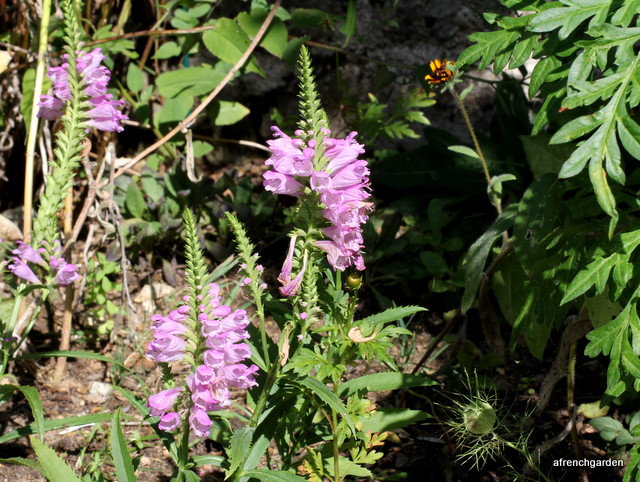

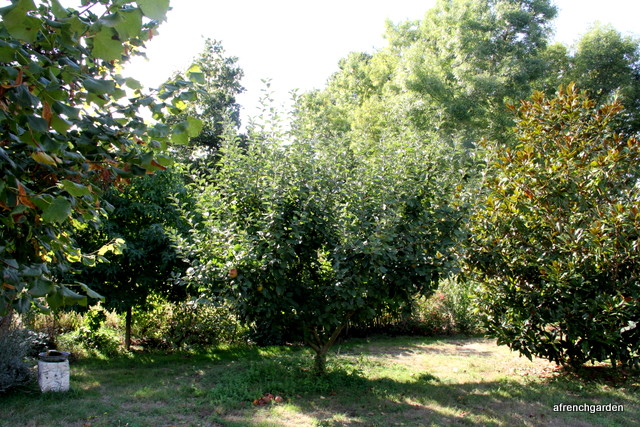
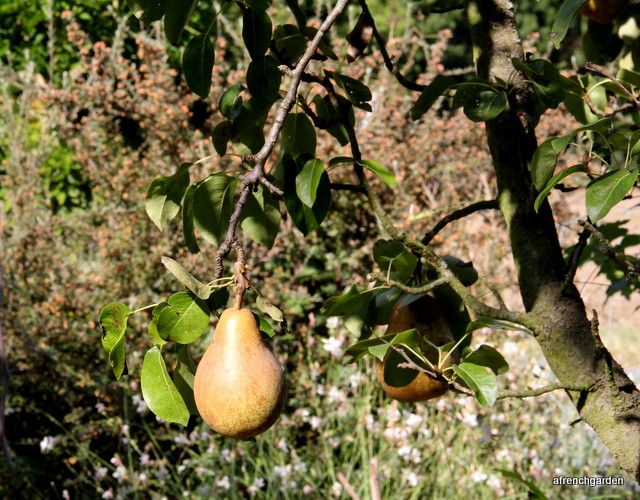
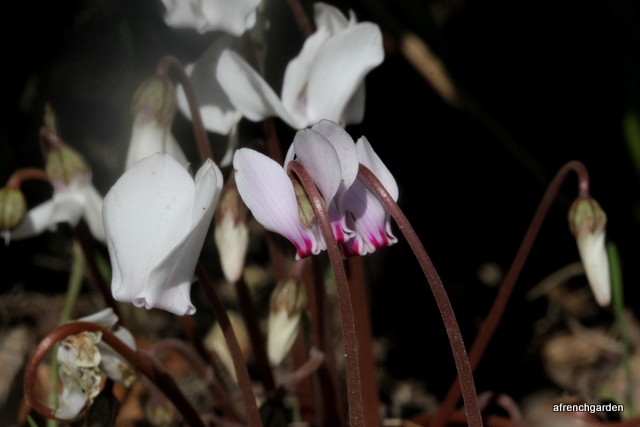


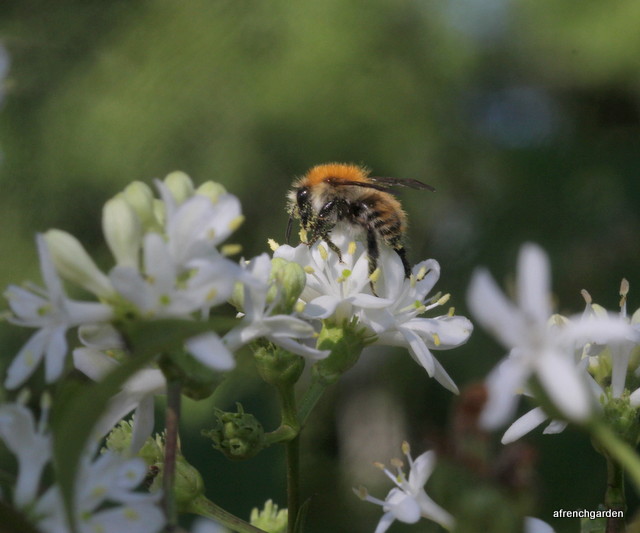





Lovely post – I think your last could be Physostegia virginiana. But I am often wrong! I notice loads of bees on our recently planted asters, as well as the ivy. It’s mesmerising!
LikeLike
I’ve checked Wiki images and that is the flower. What a forgettable name, certainly a mouthful. It is in the mint family so perhaps the bees will like it. I am just discovering asters and the low purple ones I planted last year are working very well with the Cosmos. Amelia
LikeLiked by 1 person
Another great post.
LikeLike
Thank you. Amelia
LikeLike
Beautiful caterpillar. I’m raising a Papilio polyxenes I found on the carrots and am expecting it to go through winter as a pupa. Markings almost like yours but lasers orange and it’s a lovely green where yours is white. I just love the little things.
LikeLike
Less orange, not lasers, cool as that would be.
LikeLike
And I thought it was some technical term to describe markings on caterpillars! It is interesting to raise caterpillars when you have found out their food. P. polyxenes is not one I will see in the garden but it is a real beauty. Amelia
LikeLiked by 1 person
Your last plant is indeed Physostegia virginiana, or obedient plant. It can be weedy so you’ll want to keep an eye on it if there are plants you care about nearby.
LikeLike
So it is not so obedient? So far I have been impressed that it survived the baking, dry summer but maybe it will be good as long as I keep an eye on it. Thanks. Amelia
LikeLiked by 1 person
Basil is such a fragrant herb. Maybe the bee got a bit high from licking the leaf.
It’s good to see that you still have bees – there was such a worry about the decline in their numbers. Do you have many?
LikeLike
We have five hives. Two of those are divisions of one of our first swarms. Bees are pretty resilient creatures, it is a terrible commentary on our present environment that they cannot find enough nectar and pollen and that so much pesticides are used – including in peoples gardens. Gardens are becoming more important resources for the bees now in urban areas and remember its only the honey bees that most people see or care about. There are so many beautiful, wild bees (over 20,000 species world wide) that are suffering too. We gardeners can at least take a small step by making sure there is plenty for them in our gardens. 🙂 Amelia
LikeLike
I’m fascinated by the bee behaviour you observed. In our garden they love the basil flowers (both sweet basil, Ocimum basilicum and a more pungent variety that may be O. americanum, or a hybrid through natural cross-pollination). But I have never seen them on the leaves. As the leaves are bursting with volatile oils, maybe you are right and the bee was going for a quick tipple of strong stuff: chemicals in basil have multiple uses in herbal medicine, are mildly sedative, and relieve anxiety. Some species are used homeopathically. Perhaps the bee needed to calm herself for some reason?!
Interestingly, I have found patches of peel scraped off our kumquats: again, the fruit is full of essential oil. It’s possible the bees are doing this, or it could be fruit flies. I haven’t caught the culprits.
What a fascinating subject for study: do insects know instinctively all the nutrients and chemical therapies they need?
LikeLike
I like the idea of the bee resorting to the basil after a stressful flight. Maybe she had just been chased by a hornet! Seriously, they do gather lots of resins and plant products for their propolis and wax as well as the honey, it is just we don’t always see them at it. Amelia
LikeLike
My best guess would be that the honey bee on the basil is enjoying some volatile substance, but it’s just a guess.
I got stung by a bee yesterday. I can’t remember the last time that happened. It was at the supermarket of all places. It must have been sitting on my bag of bananas and stung me as I loaded them into the car. I was thankful I am not allergic, but I did do a bit of hopping up and down and swearing. It swelled up till I thought my finger would burst, but has since gone down a bit and is now just like regular mild electric shocks.
LikeLike
That sounds a pretty bad reaction nevertheless. Did you manage to scrape the stinger out?
I lean towards the idea of some essence on the leaf surface, maybe just what was needed for the propolis she was working on :). Amelia
LikeLike
Fascinating about the bee on the Basil, I do see bees on my basil but mine invariably have flowers so I’d assumed they were collecting nectar or pollen.
LikeLike
Until now I had only seen them on the flowers, too. We took off some comb that they had put between the frames and filled with honey just before we treated them. The honey had a very herby flavour and was completely different from the summer honey. I thought it tasted more of thyme, which makes sense as there is a lot around at this time. Some beekeepers try and collect autumn honey too but we were too concerned there would not be enough left for the bees in winter. It would be interesting to see what you would get before the ivy flowered as we have heard that, although nutritious for the bees, it does not have a pleasant flavour. Amelia
LikeLike
How brilliant that a sprinkle of rain has caused your cyclamen to emerge and I love the idea of the basil ice lolly. Cannot answer your questions, sorry
LikeLike
Nobody seems to have any ideas on my Heptacodiums. Perhaps some tender loving care and some compost will coax them to produce some perfume. Amelia
LikeLike
Wonderful swallowtail caterpillar!
LikeLike
I hope he makes it through the winter as I don’t see many Swallowtails. Amelia
LikeLike
Nice post, Amelia. You have such a lovely garden. I have obedient plant in my garden, but it is overgrown with cone flower, so the obedient plant does not do as well there. I think the obedient part comes from the fact that you can manually twist the flower head and it stays in that new position (or that’s what I’ve been told).
LikeLike
Wow! I am just off to try that! Thanks for letting me know where the name came from. Amelia
LikeLike
Glad to see your ivy bees are out and about, their cycle is in full swing by the coast in Devon.
LikeLike
Our ivy is very disappointing this year, it is suffering from the lack of rain here. It is just our small area, there has been rain to the north, south and east but it always just misses us. Amelia
LikeLike
Your photo series is so special, I am already missing summer, but I do love the sights of fall.
LikeLike
Our summer is going on and on this year, with no rain unfortunately. I do agree with you that autumn is a very special and beautiful time and I enjoy the colour changes and collecting chestnuts. Amelia
LikeLike